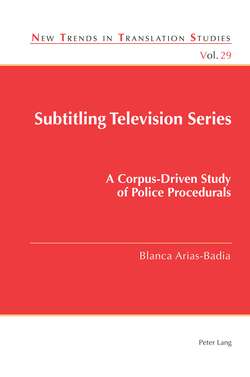Читать книгу Subtitling Television Series - Blanca Arias-Badia - Страница 13
На сайте Литреса книга снята с продажи.
ОглавлениеTables
Table 1. Corpas-Pastor’s (2008: 53) distinction between corpus-based and corpus-driven research in Linguistics
Table 2. Four components of the audiovisual text (from Zabalbeascoa 2008a: 24)
Table 3. Types of language according to Koch and Oesterreicher (1990)
Table 4. Summary of features typically attributed to spoken and written language
Table 5. Dexter: series’ details
Table 6. The Mentalist: series’ details
Table 7. Castle: series’ details
Table 8. Duration and word count of the episodes in the CoPP
Table 9. Previous accounts on ST-TT word reduction (selection of works)
Table 10. Participants involved in each type of sequence
Table 11. Language varieties in the CoPP
Table 12. Percentage distribution of lexical word categories in the CoPP
Table 13. p-values after computing t-tests on relative frequencies of each lexical word category (same series, ST vs TT version)
Table 14. p-values after computing ANOVA on relative frequencies of lexical word categories comparing Castle, Dexter and The Mentalist
←xix | xx→
Table 15. Linear discriminant analysis results for PoS distribution (ST)
Table 16. Linear discriminant analysis results for PoS distribution (TT)
Table 17. Number of sentences in each episode of the CoPP
Table 18. p-values after computing t-test on number of sentences (same series, ST vs TT)
Table 19. p-values after computing ANOVA on number of sentences comparing Castle, Dexter and The Mentalist
Table 20. Sentences per subtitle in the CoPP
Table 21. p-values after computing t-test on types of clauses (ST vs TT comparison)
Table 22. p-values after computing ANOVA on types of clauses comparing Castle, Dexter and The Mentalist
Table 23. Sentence length scores in the CoPP
Table 24. p-values after computing t-test on sentence length (same series, ST vs TT)
Table 25. p-values after computing ANOVA on sentence length comparing Castle, Dexter and The Mentalist
Table 26. Conjuncts considered for analysis of coordination in the CoPP
Table 27. Sentence coordination in Castle, Dexter and The Mentalist (relative frequencies)
Table 28. p-values after computing t-test on sentence coordination (same series, ST vs TT)
Table 29. p-values after computing ANOVA on sentence coordination comparing Castle, Dexter and The Mentalist
Table 30. Clause subordinators considered by the IULA TreeTagger (sample)
Table 31. Subordination occurrence values in the CoPP (relative frequencies)
←xx | xxi→
Table 32. Distribution of types of subordinated clauses in the ST (relative frequencies)
Table 33. Distribution of types of subordinated clauses in the TT (relative frequencies)
Table 34. p-values after computing t-test on subordination occurrence (same series, ST vs TT)
Table 35. p-values after computing ANOVA on subordination occurrence comparing Castle, Dexter and The Mentalist
Table 36. p-values after computing t-test on type of verbal group occurrence (all series, ST vs TT)
Table 37. p-values after computing t-test on nominal clause occurrence (same series, ST vs TT)
Table 38. p-values after computing ANOVA on nominal clause occurrence comparing Castle, Dexter and The Mentalist
Table 39. Main results of the quantitative study of the CoPP’s syntax
Table 40. Number of subtitles analysed in each episode for the study of segmentation
Table 41. Percentage of two-liners per episode
Table 42. Segmentation within two-liners: commented examples
Table 43. Percentage of split sentences per episode
Table 44. Segmentation across subtitles: commented examples
Table 45. Fifty most frequent words in the English STs of the CoPP
Table 46. Fifty most frequent words in the Spanish TTs of the CoPP
Table 47. Linear discriminant analysis results for corpus aboutness (ST)
←xxi | xxii→
Table 48. Linear discriminant analysis results for corpus aboutness (TT)
Table 49. Type-token ratio of Castle, Dexter and The Mentalist
Table 50. p-values after computing t-test on TTR (same series, ST vs TT)
Table 51. p-values after computing ANOVA on TTR comparing Castle, Dexter and The Mentalist
Table 52. Vocabulary richness scores in Castle, Dexter and The Mentalist
Table 53. p-values after computing t-test on vocabulary richness (same series, ST vs TT)
Table 54. p-values after computing ANOVA on vocabulary richness comparing Castle, Dexter and The Mentalist
Table 55. p-values after computing t-tests on vocabulary richness by series pair
Table 56. Function words and lexical words computed for the study of information load in the CoPP
Table 57. Information load scores in Castle, Dexter and The Mentalist
Table 58. p-values after computing t-test on information load (same series, ST vs TT)
Table 59. p-values after computing ANOVA on information load comparing Castle, Dexter and The Mentalist
Table 60. p-values after computing t-tests on information load by series pair (TT versions)
Table 61. Examples of terminological units in the CoPP, from M01
Table 62. p-values after computing t-test on terminological density (same series, ST vs TT)
←xxii | xxiii→
Table 63. p-values after computing ANOVA on terminological density comparing Castle, Dexter and The Mentalist
Table 64. Main results of the quantitative study of the CoPP’s lexicon
Table 65. Terms of endearment in C01 and C02
Table 66. Resources for the study of lexical exploitation in the CoPP
Table 67. Exemplification of levels of metaphor (from least to most creative)
Table 68. Sample of genre-specific anomalous collocates found in the corpus
Table 69. Main results of the qualitative study of the CoPP’s lexicon
Table 70. Quantitative analysis of morphosyntactic features of the CoPP
Table 71. Quantitative analysis of lexical features of the CoPP
Table 72. Presence of syntactic features typically attributed to spoken or written language in the CoPP
Table 73. Presence of lexical features typically attributed to spoken or written language in the CoPP
←xxiii | xxiv→←0 | 1→
